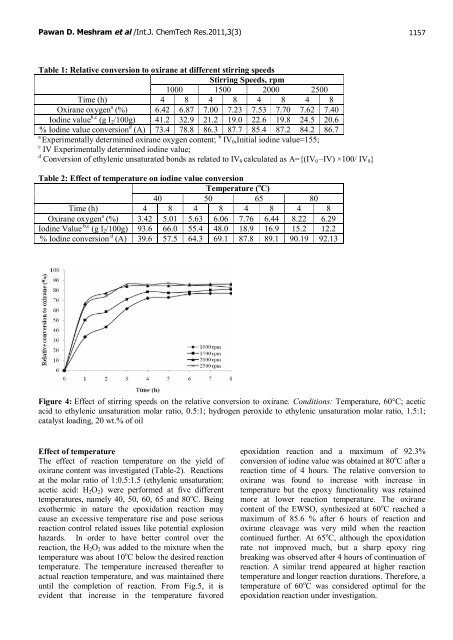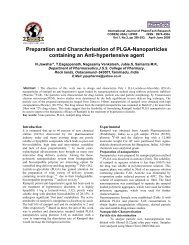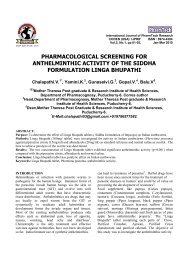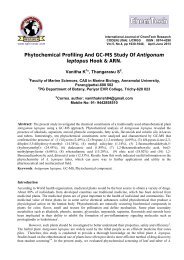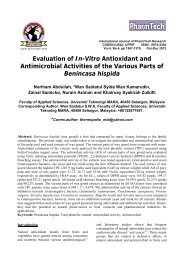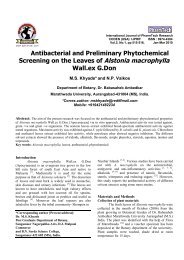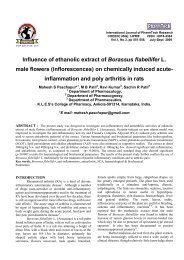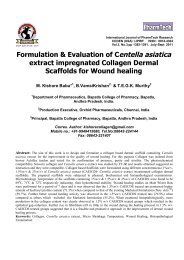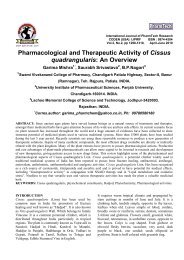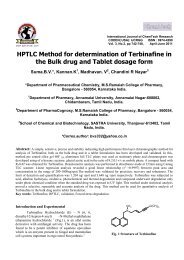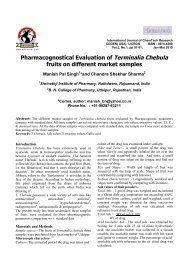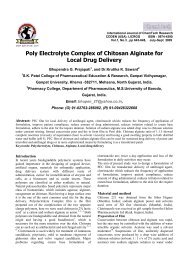epoxidation of wild safflower (carthamus oxyacantha) - Research ...
epoxidation of wild safflower (carthamus oxyacantha) - Research ...
epoxidation of wild safflower (carthamus oxyacantha) - Research ...
You also want an ePaper? Increase the reach of your titles
YUMPU automatically turns print PDFs into web optimized ePapers that Google loves.
Pawan D. Meshram et al /Int.J. ChemTech Res.2011,3(3) 1157<br />
Table 1: Relative conversion to oxirane at different stirring speeds<br />
Stirring Speeds, rpm<br />
1000 1500 2000 2500<br />
Time (h) 4 8 4 8 4 8 4 8<br />
Oxirane oxygen a (%) 6.42 6.87 7.00 7.23 7.53 7.70 7.62 7.40<br />
Iodine value b,c (g I2/100g) 41.2 32.9 21.2 19.0 22.6 19.8 24.5 20.6<br />
% Iodine value conversion d (A) 73.4 78.8 86.3 87.7 85.4 87.2 84.2 86.7<br />
a Experimentally determined oxirane oxygen content; b IV0,Initial iodine value=155;<br />
c IV Experimentally determined iodine value;<br />
d Conversion <strong>of</strong> ethylenic unsaturated bonds as related to IV0 calculated as A={(IV0 –IV) ×100/ IV0}<br />
Table 2: Effect <strong>of</strong> temperature on iodine value conversion<br />
Temperature ( o C)<br />
40 50 65 80<br />
Time (h) 4 8 4 8 4 8 4 8<br />
Oxirane oxygen a (%) 3.42 5.01 5.63 6.06 7.76 6.44 8.22 6.29<br />
Iodine Value b,c (g I2/100g) 93.6 66.0 55.4 48.0 18.9 16.9 15.2 12.2<br />
% Iodine conversion d (A) 39.6 57.5 64.3 69.1 87.8 89.1 90.19 92.13<br />
Figure 4: Effect <strong>of</strong> stirring speeds on the relative conversion to oxirane. Conditions: Temperature, 60°C; acetic<br />
acid to ethylenic unsaturation molar ratio, 0.5:1; hydrogen peroxide to ethylenic unsaturation molar ratio, 1.5:1;<br />
catalyst loading, 20 wt.% <strong>of</strong> oil<br />
Effect <strong>of</strong> temperature<br />
The effect <strong>of</strong> reaction temperature on the yield <strong>of</strong><br />
oxirane content was investigated (Table-2). Reactions<br />
at the molar ratio <strong>of</strong> 1:0.5:1.5 (ethylenic unsaturation:<br />
acetic acid: H2O2) were performed at five different<br />
temperatures, namely 40, 50, 60, 65 and 80 o C. Being<br />
exothermic in nature the <strong>epoxidation</strong> reaction may<br />
cause an excessive temperature rise and pose serious<br />
reaction control related issues like potential explosion<br />
hazards. In order to have better control over the<br />
reaction, the H2O2 was added to the mixture when the<br />
temperature was about 10 o C below the desired reaction<br />
temperature. The temperature increased thereafter to<br />
actual reaction temperature, and was maintained there<br />
until the completion <strong>of</strong> reaction. From Fig.5, it is<br />
evident that increase in the temperature favored<br />
<strong>epoxidation</strong> reaction and a maximum <strong>of</strong> 92.3%<br />
conversion <strong>of</strong> iodine value was obtained at 80 o C after a<br />
reaction time <strong>of</strong> 4 hours. The relative conversion to<br />
oxirane was found to increase with increase in<br />
temperature but the epoxy functionality was retained<br />
more at lower reaction temperature. The oxirane<br />
content <strong>of</strong> the EWSO, synthesized at 60 o C reached a<br />
maximum <strong>of</strong> 85.6 % after 6 hours <strong>of</strong> reaction and<br />
oxirane cleavage was very mild when the reaction<br />
continued further. At 65 o C, although the <strong>epoxidation</strong><br />
rate not improved much, but a sharp epoxy ring<br />
breaking was observed after 4 hours <strong>of</strong> continuation <strong>of</strong><br />
reaction. A similar trend appeared at higher reaction<br />
temperature and longer reaction durations. Therefore, a<br />
temperature <strong>of</strong> 60 o C was considered optimal for the<br />
<strong>epoxidation</strong> reaction under investigation.


